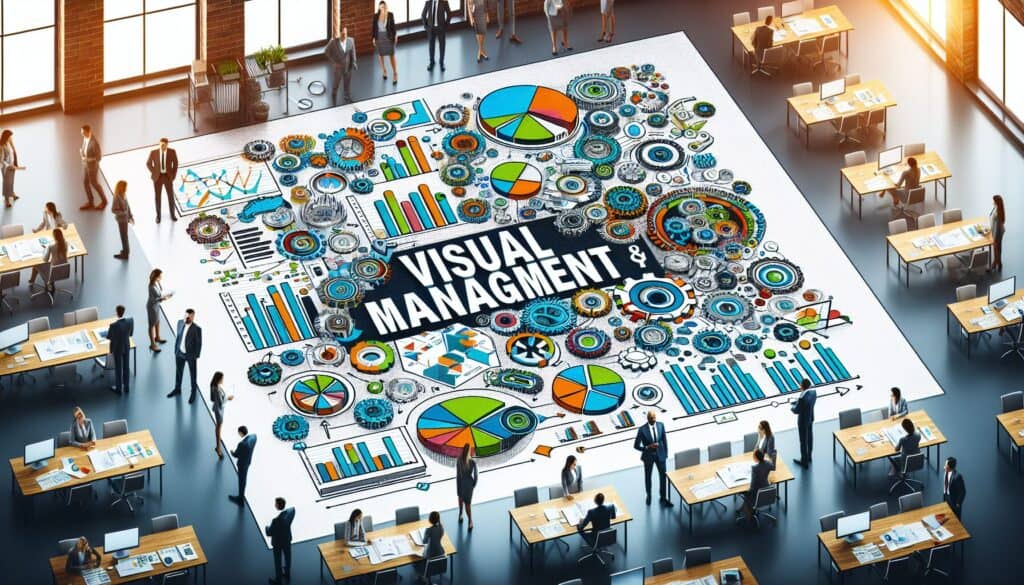Um Informationen über Prozesse, Leistung, Normenund Probleme sofort ersichtlich und für jeden am Arbeitsplatz leicht verständlich.
- Methodologien: Kunden & Marketing, Ideenfindung, Produktdesign
Visuelles Management

Visuelles Management
- Andon-System, Kontinuierliche Verbesserung, Leistungskennzahl (KPI), Schlanke Fertigung, Prozessverbesserung, Prozessabbildung, Qualitätskontrolle, Qualitätsmanagement, Visuelle Gestaltung
Zielsetzung:
Wie es verwendet wird:
- Nutzt visuelle Hilfsmittel wie Diagramme, Grafiken, Farbkodierungen, Dashboards, Schattentafeln und Andon-Lichter, um kritische Informationen in Echtzeit darzustellen und so eine schnelle Identifizierung von Anomalien zu ermöglichen und eine schnelle Reaktion zu erleichtern.
Vorteile
- Verbessert die Kommunikation und Transparenz; erleichtert die schnelle Problemerkennung und Entscheidungsfindung; fördert das Engagement und die Verantwortlichkeit der Mitarbeiter; unterstützt die Standardisierung und kontinuierliche Verbesserung.
Nachteile
- Kann zu einer Informationsüberflutung führen, wenn es nicht gut gestaltet oder fokussiert ist; Visuelles kann veralten, wenn es nicht sorgfältig gepflegt wird; Kann Anfangsinvestitionen in Displays und Materialien erfordern; Die Effektivität hängt von einer unterstützenden Kultur ab, die auf die visuellen Hinweise reagiert.
Kategorien:
- Personalwesen, Lean Sigma, Herstellung, Projektmanagement, Qualität
Am besten geeignet für:
- Klare und prägnante Vermittlung von Schlüsselinformationen durch visuelle Signale, die ein sofortiges Verstehen und Handeln am Arbeitsplatz ermöglichen.
Visuelles Management findet breite Anwendung in Branchen wie der Fertigung, dem Gesundheitswesen, der Logistik und dem Projektmanagement, wo eine klare Kommunikation von Prozessen und Leistungen erforderlich ist. In einer Produktionsumgebung können beispielsweise Schattentafeln eingesetzt werden, um sicherzustellen, dass die Werkzeuge an die dafür vorgesehenen Plätze zurückgebracht werden, was die Organisation und Effizienz in der Fertigung verbessert. Der Einsatz von Andon-Leuchten informiert Bediener und Management über den Status von Produktionslinien und erleichtert die sofortige Reaktion auf Probleme, wodurch Ausfallzeiten reduziert werden. Im Projektmanagement können Dashboards Projektmeilensteine und -termine darstellen, so dass die Teams den Fortschritt visuell verfolgen und schnell datengestützte Entscheidungen treffen können. Diese Methode eignet sich besonders für Phasen, in denen eine schnelle Reaktion erforderlich ist, wie z. B. bei Problemlösungssitzungen oder Initiativen zur kontinuierlichen Verbesserung. Zu den Teilnehmern gehören in der Regel Teammitglieder verschiedener Ebenen, darunter Mitarbeiter an der Front, Vorgesetzte und das Management, so dass ein gemeinschaftlicher Ansatz zur Ermittlung und Lösung von Anomalien gewährleistet ist. Die Schulung in visuellen Managementtechniken kann das Engagement der Mitarbeiter noch weiter steigern, da sie dazu ermutigt werden, Verantwortung für ihre Arbeitsbereiche zu übernehmen und zu Standardisierungsprozessen beizutragen. Dieser Ansatz verbessert nicht nur die Transparenz innerhalb des Unternehmens, sondern fördert auch ein Umfeld, in dem aktiv nach kontinuierlicher Verbesserung gestrebt wird, was zu besseren Leistungsergebnissen und einer stärkeren Teamdynamik führt.
Die wichtigsten Schritte dieser Methodik
- Identifizierung der wichtigsten Leistungsindikatoren (KPIs) für den Betrieb.
- Auswahl geeigneter visueller Instrumente (Diagramme, Dashboards usw.) zur Darstellung von Informationen.
- Entwerfen Sie ein visuelles Layout, bei dem Klarheit und sofortige Verständlichkeit im Vordergrund stehen.
- Einrichtung eines Systems zur Aktualisierung in Echtzeit, um die Richtigkeit der Informationen zu gewährleisten.
- Führen Sie eine Farbcodierung oder Symbole ein, um Status und Dringlichkeit zu kennzeichnen.
- Trainieren Sie die Teammitglieder darin, visuelle Signale zu interpretieren und auf sie zu reagieren.
- Regelmäßige Überprüfung und Anpassung der visuellen Hilfsmittel auf der Grundlage von Feedback und sich ändernden Anforderungen.
- Förderung einer Kultur, in der das visuelle Management als Standardverfahren eingesetzt wird.
Profi-Tipps
- Integrieren Sie Echtzeit-Dateneingaben in Dashboards und ermöglichen Sie so dynamische Aktualisierungen, die die aktuellen Bedingungen widerspiegeln und eine sofortige Entscheidungsfindung ermöglichen.
- Verwenden Sie Farbverläufe und Symbole in visuellen Werkzeugen, um Datentrends und -abweichungen darzustellen, so dass die Benutzer die Leistung im Vergleich zu Benchmarks schnell beurteilen können.
- Durchführung regelmäßiger Überprüfungen und Aktualisierungen der visuellen Managementsysteme, um Relevanz und Effektivität bei der Anpassung an sich entwickelnde Ziele und Prozesse zu gewährleisten.
Verschiedene Methoden lesen und vergleichen, Wir empfehlen die
> Umfassendes Methoden-Repository <
zusammen mit den über 400 anderen Methoden.
Ihre Kommentare zu dieser Methodik oder zusätzliche Informationen sind willkommen auf der Kommentarbereich unten ↓ , sowie alle ingenieursbezogenen Ideen oder Links.
Historischer Kontext
1986
(wenn das Datum nicht bekannt oder nicht relevant ist, z. B. "Strömungsmechanik", wird eine gerundete Schätzung des bemerkenswerten Erscheinens angegeben)

Verwandte Artikel
Fragebögen zu muskuloskelettalen Beschwerden
Multivariate Tests (MVT)
Mehrfache Regressionsanalyse
Motion-Capture-Systeme
MoSCoW-Methode
Moods Median-Test